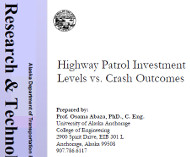1/19/2018
Alaska Studies Whether Rural Speed Traps Reduce CrashesNo conclusive safety benefit was found in a preliminary analysis of police patrols on rural Alaska highways.

It is often assumed that encouraging police to set up speed traps enhances road safety. A test conducted last year called this assumption into question. The Alaska Department of Transportation tapped a team of university researchers to come up with a methodology to evaluating whether heavy patrolling of Alaska's rural highways produced a statistically significant reduction in collisions. The first look at one year's worth of data failed to demonstrate a conclusive safety benefit.
"Apart from the Richardson Highway, no statistical significance exists for all other study corridors under the macro logistic regression analysis," the study found. "This could be indicative of the data characteristics of the Richardson Highway versus the other four study corridors. The Richardson Highway experiences the lowest traffic volumes versus other study corridors, which can result in the lowest probability of multivehicle crashes."
The University of Alaska Anchorage researchers collected collision reports from Alaska State Troopers operating on the Glenn Highway, the Parks Highway, the Richardson Highway, the Seward Highway and the Sterling Highway. The researchers even convinced the troopers to install black boxes in their patrol cars that recorded speed and location data that were uploaded to a server every twenty seconds.
These numbers will be used to conduct a cost-benefit analysis for the patrols. The study found, for example, that troopers spent 900 hours patrolling the Sterling Highway in July 2016 at a cost of $135,000. Despite the police presence, there were thirteen traffic accidents during that period.
When the researchers attempted to factor traffic volumes into the accident analysis, two road sections yielded statistically significant results, while the other three did not. The analysts also attempted to slice the data into monthly and even daily segments. Ultimately, they concluded that they would need a full three years of data to arrive at answers with more relevance.
"The primary goal for future research is the inclusion of more data, including consideration of more independent factors involved with crash occurrences -- such as roadway conditions, intersecting side street traffic volumes, hours involving high alcohol consumption -- and socioeconomic factors such as unemployment, population density and urban/rural environments," the study concluded.
A copy of the report is available in a 1.6mb PDF file at the source link below.


